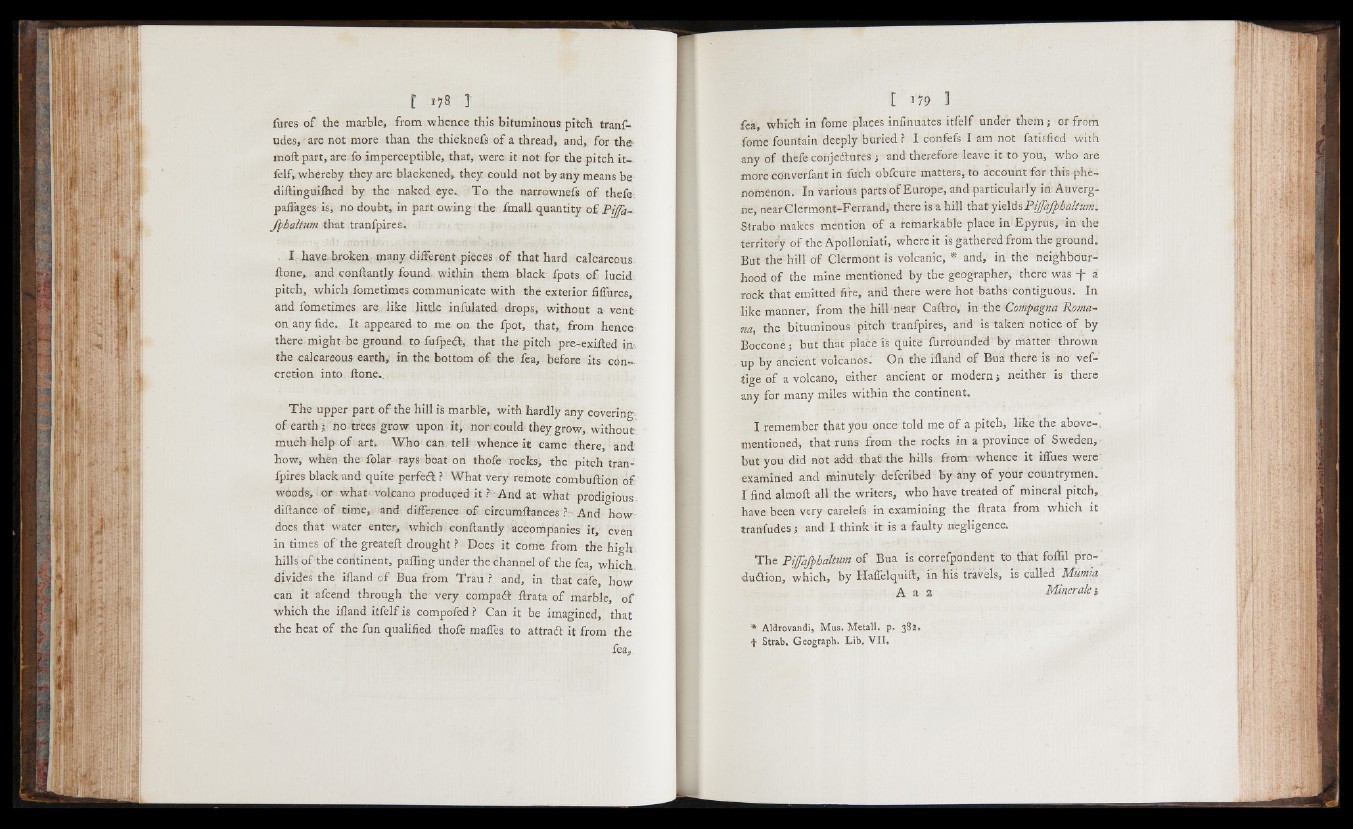
lures o f the marble, from whence this bituminous pitch tranf-
udes, are not more than the thicknefs o f a thread, and, for the
moftpart, are fo imperceptible, that, were it not for the pitch it—
felf, whereby they are blackened, they could not by any means be
diftinguiihed by the naked eye. T o the narrownefs o f thefe
pafiages is, no doubt, in part owing the fmall quantity o f Pijfa-
fphaltum that tranfpires.
I have broken many different pieces o f that hard calcareous
ftone, and conftantly found, within them black- fpots o f lucid:
pitch, which fometimes communicate with the exterior fiffures
and fometimes are like little infulated drops, without a vent
on any fide. It appeared to me on the fpot, that, from hence
there might be ground to fufpedl, that the pitch pre-exifted i,n-,
the calcareous earth, in the bottom o f the fea, before its concretion
into ftone-
The upper part o f the hill is marble, with hardly any covering
o f earth j iio trees grow upon it, noncould they grow, without
much help o f art. Who can: tell whence it came there, and
how, when the folar rays beat on thofe rocks-, the pitch tranfpires
black and quite perfed ? What very remote combuftion of.
woodsy o r what: volcano produced it ?" And at what prodigious,
diftance o f time, and difference o f circumftances? And how
does that water enter, which conftantly accompanies it, even
in times of the greateft drought ? Does it come from the high ;
hills of the continent, palling under the channel o f the fea, which
divides the ifland o f Bua from Trau ? and, in that cafe how
can it afcend through the very compacft lirata o f marble, o f
which the ifland itfelf is compofed ? Can it he imagined, that
the heat o f the fun qualified thofe maffes to attrait it from the
fea>
fea, which in fome places infinuates itfelf under them; or from
fome fountain deeply buried ? I confefs I am not fatisfied with
any of thefe cohjedutes j and therefore leave it to you, who are
more converfant in fuch obfcure matters, to account for this-phe-
nomenon. In various parts of Europe, and particularly in Auvergne,
near Clermont-Ferrand, there is a hill that yields Pijfdfphaitum.
Strabo makes mention o f a remarkable place in Epyrus, in the
territory of the Apolloniati, where it is gathered from the ground.
But the hill o f Clermont is volcanic, * and, in the neighbourhood
o f the mine mentioned by the geographer, there was f a
rock that emitted fire, and there were hot baths'contiguous. In
like manner, from the hill near Caftro, in the Compagna Roma~
na, the bituminous pitch tranfpires, and is taken notice o f by
Boccone ; but that plate is quite furrounded by matter thrown
up by ancient volcanos. On the ifland o f Bud there is no vef-
tige o f a volcano, either ancient or modern j neither is there
any for many miles within the continent.
I remember that you once told me o f a pitch, like the above-,
mentioned, that runs from the rocks in a province o f Sweden,
but you did not add that the hills f r om whence it iflues were
examined and minutely defcribed by any o f your countrymen.
I find almoft all the writers, who have treated o f mineral pitch,
have been very careleis in examining the ftrata from which it
tranfudes j and I think: it is a faulty negligence.
The Pijafphaltum o f Bna is correfpondent to that foflil pro-
dudion, which, by Haflelquift, in his travels, is called Mumia
A a 2 Miner ale >
* Aldrovandi, Mus. Metall, p. 382*
t Strab. Geograph. Lib. V I I .